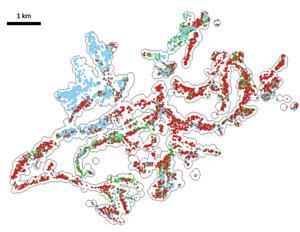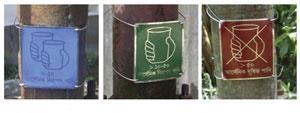Arsenic-laced water is still poisoning millions of people in Asia. Nina Notman looks to see if an end is in sight

The presence of high levels of naturally occurring arsenic in water used for drinking has been referred to as the largest mass poisoning in history. The element has been found in groundwater in at least 70 countries and could affect the health of more than 140 million people, according to the United Nations Children’s Fund, Unicef.
In the second half of the 20th century, concerns grew about bacterial pathogens in surface water causing diarrhoeal disease and high infant mortality. This led to an international drive to encourage people without access to treated water to use groundwater instead. Millions of vertical pipes, bored approximately 30m into the ground, with hand pumps at the top, were installed. Most farms and households in regions of Asia without piped water have dug themselves at least one shallow well on their land.
But by the mid-1980s, it became apparent that all was not well. In West Bengal, an eastern region of India, previously unseen skin lesions were appearing with alarming frequency. These were identified as symptoms of arsenic poisoning, and the source traced back to the water from the wells. Within a few years, it was identified that Bangladesh was suffering from a similar public health emergency on an even larger scale. The subsequent decade saw the issue identified in other parts of India, as well as Vietnam, Cambodia, Pakistan, Nepal and Burma.
Biding its time
Arsenic at the levels found in groundwater doesn’t kill instantly. Instead it takes between five and 20 years for any physical warning signs to be seen. Unsightly lesions and spotted skin pigmentation are common first symptoms, but arsenic is poisonous for just about every system in the body. ‘Arsenic causes many more disease and [negative] health outcomes than any other toxic element we know of,’ explains epidemiologist Allan Smith from the University of California at Berkeley in the US. Smith has been working on the effects of long-term exposure to arsenic through groundwater since the early 1990s. ‘The first increased cause of mortality is cardiovascular disease, and later the cancers take over.’ Lung and bladder cancers are the two most common fatal cancers in affected people, Smith says.

The skin lesions are a late manifestation of the disease, explains Dipankar Chakraborti, the director of the school of environmental studies at Jadavpur University in West Bengal. Chakraborti was one of the early whistleblowers on the presence of elevated levels of arsenic in groundwater in West Bengal and then Bangladesh. ‘The appearance of skin lesions means severe internal damage has already occurred and the victim’s life is in danger,’ he says. Chakraborti has screened over 100,000 people from arsenic-affected villages in West Bengal over the past 25?years, and while only 10% of people had skin lesions, around 85% had elevated levels of arsenic in their hair, nails and urine.
Worse still, Smith has recently found that arsenic’s effects are unexpectedly long-lasting. ‘The risks continue 40 years after exposure has stopped,’ says Smith. ‘Much longer than the effects of smoking, which drop 10 to 20 years after people stop.’
Another very large scale epidemiology study, led by Habibul Ahsan at the University of Chicago in the US, has provided further proof of the scale of the problem. His team has been tracking the health of nearly 30,000 adults with a wide range of arsenic exposure living in the Araihazar district of Bangladesh since 2000. ‘Up to a fifth of deaths in this population who are exposed to arsenic could be attributed in part to arsenic,’ Ahsan says.
The source of the problem
Arsenic is naturally present in rock and soil throughout the world. But the amount of arsenic in the sediment next to water has no impact on the amount of arsenic in the water, explains Charles Harvey, a hydrogeologist at the Massachusetts Institute of Technology in the US. Instead, it depends on the environmental conditions. In the right conditions, any soil could release arsenic to groundwater to the point where it causes a health problem.

‘It is clear that high arsenic is seen in water that is anoxic [oxygen depleted] and that is consistent with the idea that arsenic has been mobilised by reductive dissolution of oxides,’ says Harvey. Microbes naturally present in water need oxygen to degrade organic matter and turn it into carbon dioxide. In water with less dissolved molecular oxygen, these bacteria strip oxygen from wherever they can: first from nitrate and sulfate in the water, and then from oxides such as iron oxide in the sediment. Arsenic is naturally adsorbed onto iron oxides in the sediment, and when that is reduced, the arsenic is left homeless and goes into the water. Water at the depths that shallow wells pump from is often anoxic because the molecular oxygen has been consumed when the water filtered through the soil from the surface to the aquifer.
‘We don’t have the full scale experiments to prove this reductive dissolution mechanism yet,’ says Harvey. Large scale studies, over a long period of time, are needed to map groundwater flow patterns over a large area, and measure iron oxides in rock and the arsenic levels in the neighbouring water. ‘It would be nice to take measurements for a couple of years and show that there were iron oxides here and now they are dissolving and as a result of that arsenic is liberated into the water,’ says Harvey. But this would cost millions of dollars to do, he concedes.
Much of Harvey’s research is focused on establishing where the organic carbon involved in the reductive dissolution process has come from. His team has used carbon dating to show that most of the organic carbon metabolised by bacteria in the aquifers is less than 50 years old. Ancient deposits of organic carbon are not involved in this process. ‘That isotopic method is a powerful way to rule out some of the potential sources of organic carbon that would have driven the groundwater to be in such an anoxic state,’ says Harvey.
Currently, he is studying what happens to fresh sources of organic carbon as they infiltrate down from the surface to an aquifer. Three years ago, his team built an artificial lake on top of newly installed wells and instruments in the Munshiganj district in central Bangladesh. The lake has fish to keep plant and algae productivity high, providing a source of organic carbon that will slowly sink down to the aquifer and be eaten by microbes present there. ‘We are tracking the organic carbon as it moves into the aquifer,’ he says.
Testing times
Alexander van Geen, a geochemist at Columbia University in New York, US, has been focusing his efforts on testing wells that are already in use. In 2000, his team measured the levels of arsenic in 5000 wells in Bangladesh and, armed with the GPS location of each well, looked at the spatial variability. ‘What was striking is that the distribution was very heterogeneous,’ he says. ‘We calculated that, over our area, 50% of the people had wells with water that they should not be drinking from. However, 90% of these same households lived within 100m of a safe well.’

But it is often difficult for villagers to know which wells are safe, as arsenic has no taste, colour or smell. ‘There was a blanket testing campaign a decade ago and over 5 million wells were tested, including our study area,’ says van Geen. Tested wells were labeled appropriately. ‘We just finished retesting 50,000 wells in our area and found that two-thirds of the wells had a status that was unknown because they had been installed since the initial testing.’ There is no convenient way for households to have new wells tested, he explains. The governments in India and Bangladesh only test wells that they have installed.
‘We are working on trying to develop a market for testing,’ says van Geen. ‘We had a study in Bihar, India, to establish the demand for testing wells for arsenic and found that for 10 rupees [£0.10] 90% of the people in this area were willing to buy the test and then it dropped fairly steeply to 50% uptake at 50 rupees,’ he says. ‘If you include the testing, the quality control, and the stainless steel plaque with the result, the price is closer to $2.00·2.50 [£1.20·1.50].’ He is proposing that only the salary of the tester be paid for by the household, with materials and quality control subsidised by government funds or an international aid agency.
But what levels are they testing for? The World Health Organization (WHO) has set the guideline limit of arsenic in drinking water at 10µg/l, while the national standards for many of the affected countries is 50µg/l. The team led by van Geen therefore labels tested wells blue (0–10µg/l), green (10–50µg/l) or red (above 50µg/l). This doesn’t always go down well with government officials advocating that below 50µg/l is safe, he says.

Meanwhile, Chakraborti is questioning whether the WHO recommended limit itself is low enough. ‘The WHO guideline value of 10ppb [is calculated assuming that] one drinks two litres of water per day. In Asian countries, adults drink on average four litres of water per day,’ he says. ‘So for these countries the WHO guideline value should be a third lower.’ The nutritional status of the individual also influences what level is safe for them. People with a healthier diet are less likely to have skin lesions, says Chakraborti.
Digging deep
A robust, affordable and permanent testing service will work well to remediate this issue in villages with a mix of high- and low-arsenic wells. But in some regions all the shallow wells have high levels of arsenic. ‘What has been most successful there is the installation of community wells which tap deeper aquifers,’ say van Geen. ‘The Bangladesh government, with money from various donors, has installed over 200,000 of those wells.’ Compared to shallow wells costing around $100, deeper community wells typically cost $1000 to $2000 to install.
The assumption here is that water in deeper aquifers contains less arsenic, something which is generally – but not always – true. ‘Most deep wells are in older rocks,’ explains John McArthur, a geochemist at University College London in the UK. ‘All the arsenic-polluted wells are in sediments that were deposited within the past 20,000 years, while all the deeper wells are in sediments that were deposited before 120,000 years,’ he says. There is less arsenic in the deeper aquifers because there isn’t any organic carbon in the older rock.
Deep wells are a jolly good interim fix and may well be a long-term fix
John McArthur
It is possible that deeper wells could become contaminated with arsenic over time, however. When water is pumped from deep wells, it must be replaced by fresh water. ‘The fear is that this new water is flowing in from the shallow aquifers that are overlying the deeper aquifers and drawing arsenic in with it,’ explains McArthur. But there is no consensus view yet on whether this can actually occur. ‘Modelling is not easy because as the arsenic travels from the polluted aquifers into the arsenic-free aquifers a lot of it is adsorbed to the sediment it passes along the way.’ Additionally, the deeper aquifers tend to contain some iron oxide, which adsorbs any arsenic that has made it down that far.
McArthur, Harvey and van Geen have all recently reported examples of deeper aquifers becoming polluted over time due to pumping. ‘Those are the exceptions rather than the rule though,’ says van Geen. ‘I think these examples have been a red herring to a large extent.’
‘We need to figure out whether these deep wells will work over a long period of time but there are some advantages of having safe water immediately,’ says Harvey. McArthur also backs community wells: ‘They are a jolly good interim fix and it may well be a long-term fix.’
Support for deep wells may also come from McArthur’s recent finding that a thick clay layer 25–35m down exists across much of the region. This layer prevents arsenic in upper aquifers from reaching lower aquifers. ‘We have found that it is very widespread and it means that across at least a third of the Bengal basin if you put a well more than 35m down you are putting it into an aquifer into which arsenic cannot percolate downwards because the clay gets in the way,’ says McArthur. Van Geen cautions, however, that the clay layers could actually pose a threat if they release organic matter. This would then aid the reduction of iron oxides and the release of arsenic.
Filtering it out
Arsenic is one of the standard contaminants removed in water treatment works throughout the western world. Early on, therefore, it was hoped that arsenic could be removed from water using small filters fitted to the hand pumps at the top of the wells. These were tried across the region, but proved to be generally unsuccessful.
In West Bengal, for example, arsenic-removal kits packed with granulates such as alumina and iron oxide were fitted to 2400 shallow wells. Chakraborti monitored their progress for two years and found that none of them maintained arsenic levels in the water below the WHO guideline value and only two met the Indian standard value of 50µg/l throughout. He blamed the problem on a lack of maintenance. ‘In my opinion most of the filters are good but they must be back-washed and cleaned at regular intervals otherwise they will not work,’ he says.
Millions of people are drinking severely contaminated water right now
Charles Harvey
McArthur says there is another issue with these filters. ‘The people who designed them overlooked the fact that water that contains arsenic also contains a lot of iron. That iron clogs up these filters and that is the principal reason for them not working properly.’
Despite the ups and downs of various mitigation attempts and ongoing scientific uncertainties, the situation for people living in affected areas has improved since the problem was first identified. According to the WHO the number of people drinking water exceeding the 50µg/l national standard in Bangladesh has dropped by around 40%. But 20 million people are still using water above this level, and a further 25 million are using water above the WHO guideline value of 10µg/l. More needs to be done. ‘Millions of people are drinking severely contaminated water right now,’ says Harvey.
At what sounds like a minor cost to people in developed countries – approximately $100 per person – deep wells could be put in to provide safe water to every person in the region, he says. But then people start worrying about other minor things like how long they would last and other contaminants too. ‘But it is not a reason to refuse to do it.’ His frustration is clear.
Nina Notman is a science writer based in Salisbury, UK












No comments yet